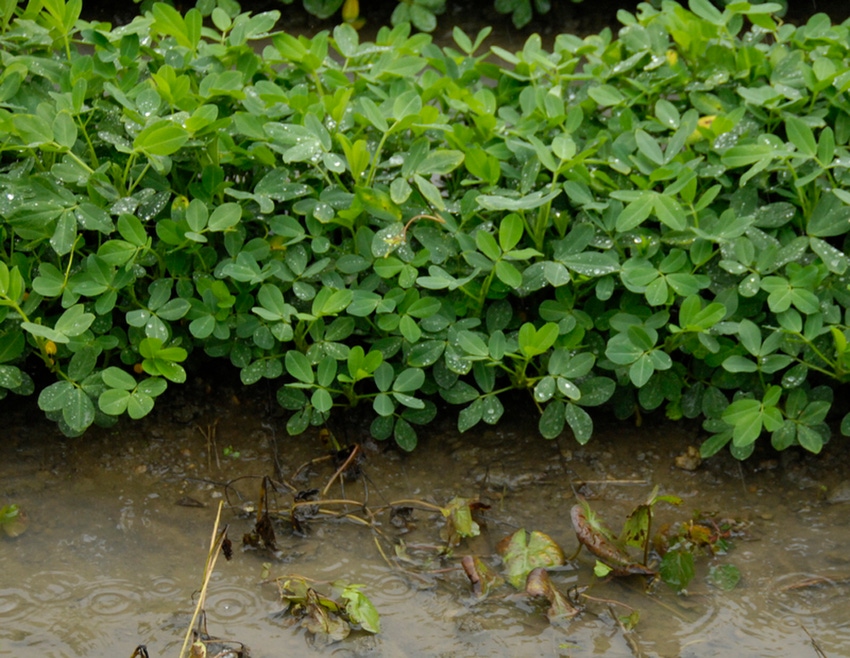
Alabama and Georgia peanut fields have been a bit swampy this summer.
Hard downpours and prolonged soggy times have created perfect disease patterns in peanuts and has hindered much-needed fungicide applications. It’s been a tricky year so far.
“Growers need to know that leaf spot, white mold, Rhizoctonia limb rot and even Cylindrocladium black rot are likely to be problematic this year,” said Bob Kemerait, plant pathologist with the University of Georgia Cooperative Extension. “Diseases will be of significant concern this season, and growers are encouraged to invest in the fungicide program their crop needs for optimal yields.”
Peanut farmers need to consider fungicides with both systemic and curative activity this year for leaf spot control. “With the weather this summer, there is a good chance that some leaf spot is already present in a field before a fungicide program can be established,” he said.
The best leaf spot programs, he said, include Headline or Provost. Fontelis works well on leaf spot, too. And for increased leaf spot control, growers now can mix Abound at 18.5 fl oz/acre with Alto at metconazole, 5.5 fl oz/acre.
“All of our soilborne programs are effective for use in our peanut fields. However Abound gets special attention for Rhizoctonia limb rot, Provost for CBR, and Artisan, Convoy and Fontelis for white mold,” he said. “Tebuconazole is a great value for the price. However it is not the best soilborne fungicide our growers can choose.”
Nitrogen on peanuts?
It’s rained and some fields have flooded. Since June 1 in Seminole County, Ga., near the Florida and Alabama lines for example, rain’s totaled 19 inches, three times the total for the same timeframe last year for the area. Half that total came the first week in July.
In extreme cases, a dose of N might be needed on soggy peanuts. “It is recommended to check peanut fields that have received abundant amounts of rain recently for nodule activity and active N-fixation,” said Scott Tubbs, UGA cropping systems agronomist.
Gather several plants from low spots in a suspect field that’s sat under water for more than two days. Slice several of the nodules open on each plant. If the nodules are pink, red or dark purple and appear moist, then those nodules are healthy and there are no concerns of reduced N-fixation, Tubbs said.
“If the interior of the nodules are gray, white, green or brown and appear dry on the interior, then those nodules are most likely no longer active,” he said. “So the chances of N deficiency will be greater as we enter into pegging and pod-fill, a very N-demanding period of crop development.”
As of July 8, a third of Georgia’s peanuts were reported as pegging, 20 percent behind the five-year average. In Alabama, 55 percent were pegging, 20 percent ahead of the five-year average.
When peanut roots and nodules are saturated and cannot get oxygen, N-fixation can cease either temporarily or permanently, Tubbs said. But the severity of it can vary widely by soil type and microclimate. And there is no hard data to show how long a peanut plant can withstand flooded conditions.
“But we theorize that if a field was in saturated soil conditions for 48 hours or less, then the crop may experience brief yellowing from temporary shut-down of nodule activity, but the crop likely will not experience any serious injury or yield loss,” Tubbs said. “Longer periods of water-logged conditions start to carry concern of damage which may need to be addressed.”
If more than 50 percent of nodules are inactive, then a foliar application of N fertilizer like ammonium sulfate may be necessary, he said. But make sure you need it, or you could make a bad thing worse.
“The supplemental N could cause the remaining active nodules to cease N-fixation, which may require multiple N applications to meet the high-N needs of the crop for the remainder of the season,” he said.
More from Southeast Farm Press
AFBF files suit to protect farmers' privacy
Kudzu bugs transforming insect control picture of soybeans
Beef producers shouldn't focus on single trait EPDs to improve herds
About the Author(s)
You May Also Like






